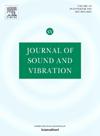Identification of operational modal parameters using multi-reference weighted Hermitian transmissibility functions
IF 4.3
2区 工程技术
Q1 ACOUSTICS
引用次数: 0
Abstract
In recent years, methods have been developed to examine the dynamic behavior of structures without affecting their performance. Among these methods, modal parameter identification based solely on output data is a cost-effective approach. Since structures are influenced by multiple input sources simultaneously, the use of poly-reference methods is essential for identifying the structural poles with minimal uncertainty. The main drawback of poly-reference methods is their dependence on loading conditions, which must differ significantly to accurately identify the structural poles. Another limitation of these methods is the presence of non-periodic harmonic components in the frequency responses of structures, which cause dispersion around the structural poles and lead to the identification of spurious poles. To address these issues, a new approach called Poly Reference Weighted Hermitian Transmissibility Operational Modal Analysis (P-WHTOMA) is employed. In this study, a 4-DOF measured structure is analyzed under three earthquake records with varying noise levels using this novel approach. This method utilizes the weight effects on the structural responses to reduce the frequency domain of the responses and minimize spectral dispersion around the structural poles. Therefore, modal parameters are identified with minimal uncertainty under similar loading conditions and correlated input sources. Furthermore, by defining transmissibility functions using Hermitian polynomials, orthogonality is established between the normal vectors of the transmissibility functions, resulting in the identification of modal parameters at the structural poles with reduced uncertainty. In this new approach, increasing noise has less impact on the identification of structural poles. Another advantage of this method is that, unlike single-reference methods, higher structural modes are identified with greater resolution.
基于多参考加权厄米传递函数的运行模态参数辨识
近年来,在不影响结构性能的情况下研究结构动力特性的方法得到了发展。在这些方法中,仅基于输出数据的模态参数识别是一种经济有效的方法。由于结构同时受到多个输入源的影响,因此使用多参考方法对于以最小的不确定性识别结构极点至关重要。多参考方法的主要缺点是它们依赖于载荷条件,要准确识别结构极点,载荷条件必须有很大的不同。这些方法的另一个限制是在结构的频率响应中存在非周期谐波分量,这会导致结构极点周围的色散并导致假极点的识别。为了解决这些问题,采用了一种称为多参考加权厄米透射率运算模态分析(P-WHTOMA)的新方法。在本研究中,使用这种新颖的方法分析了三种不同噪声水平的地震记录下的四自由度测量结构。该方法利用结构响应的权重效应来减小响应的频域,并最小化结构极点周围的谱色散。因此,在相似的载荷条件和相关的输入源下,模态参数识别具有最小的不确定性。此外,通过使用厄米多项式定义传递率函数,在传递率函数的法向量之间建立了正交性,从而降低了结构极点模态参数的不确定性。在这种新方法中,增加噪声对结构极点的识别影响较小。该方法的另一个优点是,与单参考方法不同,可以用更高的分辨率识别更高的结构模式。
本文章由计算机程序翻译,如有差异,请以英文原文为准。
求助全文
约1分钟内获得全文
求助全文
来源期刊

Journal of Sound and Vibration
工程技术-工程:机械
CiteScore
9.10
自引率
10.60%
发文量
551
审稿时长
69 days
期刊介绍:
The Journal of Sound and Vibration (JSV) is an independent journal devoted to the prompt publication of original papers, both theoretical and experimental, that provide new information on any aspect of sound or vibration. There is an emphasis on fundamental work that has potential for practical application.
JSV was founded and operates on the premise that the subject of sound and vibration requires a journal that publishes papers of a high technical standard across the various subdisciplines, thus facilitating awareness of techniques and discoveries in one area that may be applicable in others.
 求助内容:
求助内容: 应助结果提醒方式:
应助结果提醒方式:


